
How to Avoid Bunions with Proper Shoe Fit
A bunion is what’s often lovingly referred to as a “bump” protruding from the side of one’s foot, at the base of the big toe. It’s what happens when the bone or tissue at the MTP — or metatarsophalangeal joint — moves out of alignment. The result is a lot of foot pain and inflammation, along with calluses, corns, and difficulty walking due to stiffness of the big toe.
What Causes Bunions?
Bunions can be caused by inflammatory conditions such as rheumatoid arthritis, congenital deformities, or neuromuscular disorders. You may be prone to bunions if you have flat feet or low arches, work a job that puts constant stress on your feet, or have a genetic disposition for foot problems.
But there’s also a common factor that we’re all prone to: poorly fitting shoes.
Shoes that are too tight or shoes with a narrow toe box that force the toes into an unnatural position are often culprits, which might explain why women are more likely to develop bunions than men. According to a study by the American Foot and Ankle Society, 88% of women wear shoes that are too small. Of this same population, 55% had bunions.
Tips for Proper Shoe Fit
Here’s how both men and women can ensure their shoes fit properly:
- Have both feet measured before shoe shopping. One of your feet might be bigger than the other. If so, it’s best to go with the bigger size, as long as your feet aren’t slipping.
- Always try on shoes when shoe shopping. No two pairs of shoes are made the same; rather than choosing a pair solely based on size, make sure it actually fits well before purchasing it.
- Try wide sizes. If your feet feel pinched or otherwise uncomfortable in regular sizes, a wide size might be better for you. Choose shoes with a wide and deep toe box. It shouldn’t feel as if you’re squeezing your toes or the ball of your foot into the shoe.
- Avoid heels higher than two inches. But if you do go with a bit of a higher heel, go for the pair with a platform so your foot isn’t in such an extreme position.
- Walk around in a pair of shoes before purchasing it. How you walk could influence whether or not you develop a bunion, so make sure you can walk comfortably in a pair of shoes before you buy it.
If you still have bunion pain and difficulty walking after making improvements in footwear and trying other treatments, your doctor may recommend foot surgery. Such surgery removes the bunion and realigns the MTP. Bunion surgery can be painful, but there are options for a painless bunion surgery with quick recovery. Consult your doctor to learn about your options.